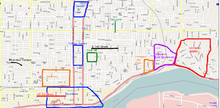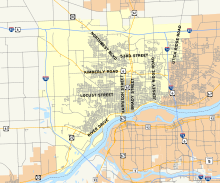Neighborhoods of Davenport, Iowa


The city of
Downtown

Downtown Davenport sits on the banks of the
Central neighborhoods
The
East Fourteenth Street has sixty-seven houses from Pershing Street to Arlington Avenue along Fourteenth Street developed during the 1840s and the 1870s. During that time, the neighborhood contained mostly middle-class Irish immigrants and Americans.[1] The houses are fairly large and range from Victorian to Classical Revival styles, and all but one of the houses are wood frame.[1] The original neighborhood housed prominent entrepreneurs, industrialists, and professionals.
College Square is located north of Downtown, from Tenth Street to Fifteenth Street and Brady Street to Harrison Street (U.S. Route 61). Two blocks of the neighborhood on Harrison Street contain mid-nineteenth-century houses. Another two blocks are dedicated to large-scale education and religious buildings, including the Palmer College of Chiropractic campus. Most of the houses in the neighborhood date from 1860 to the early twentieth century.[1] Harrison and Main streets have become more commercialized over the years, along with the east side of Brady Street, while the west side of Brady Street still contains mostly residential buildings.[1]
East neighborhoods
Bridge Avenue The historic district stretches from River Drive along the Mississippi River up a bluff to East Ninth Street, which is near the top of the hill. The neighborhood is made up of fourteen houses on the southern end of Bridge Avenue. The houses were mostly built between 1870 - 1910. The most prominent of the residences was built by Ambrose Fulton, who was significant to Davenport's early settlement and its industrial history. He was an early and aggressive promoter of the new town.


Unlike similar west end and central neighborhoods, Prospect Park has remained composed primarily of single-family homes.

The Village of East Davenport (known locally as The Village) is a neighborhood that dates back to the 1850s and was originally known as "Stubb's Eddy". The Village was established in 1851 to service the logging industry, and was annexed by the city in 1857.[1] It experienced three stages of growth: the period following the American Civil War, when many residential buildings were built; from 1890 to 1915, when construction of large mansions on the bluffs (allowing views of the Mississippi River) began; and the turn of the twentieth century, at the far east end of the neighborhood and the city. The houses in The Village were built along the curves of the topography, not in the grid fashion that was used in the rest of the city.[1]
Today, The Village consists of residential and commercial buildings (mostly small specialty shops). It is bounded to the west by Judson Street, to the north by Kirkwood Boulevard, to the east by Jersey Ridge Road, and to the south by River Drive. Set in a bowl-like valley, commercial buildings are in the southern part of the neighborhood, while residential buildings are in the northern part on the hillside. Lindsay Park is located in the southeast corner and was used as parade grounds for soldiers from Camp McClellan during the Civil War.[1] Today, the park contains play equipment and baseball diamonds and provides a view of the river.
Near north neighborhoods
At the turn of the twentieth century, development extended along transportation arteries and street car lines. The areas along Locust Street, Brady Street, and Harrison Street were developed around this time.

Columbia Avenue is a neighborhood located north and west of Vander Veer Botanical Park. The area is entirely residential and it contains brick apartment buildings that were built between 1930 and 1939. It is one of the city's smallest districts and it is unique among the other historic districts in that it contains primarily apartment buildings. The neighborhood is made up of 19 four to six unit apartment buildings that were built between 1930 and 1939 and two similar structures built in the 1950s.
Oak Lane is a neighborhood that along Oak Lane from High Street south to Locust Street. The neighborhood contains 27 middle-class houses developed from 1900 to 1910 by Amos Cutter, a local real estate entrepreneur. It is a significant example of the speculative development which appeared in Davenport in the first decades of the twentieth century.[1]
Northwest and west end neighborhoods

At the time northwest Davenport was developed, during a post-Civil War expansion, it consisted of the area around Locust Street, Marquette Street, and Washington Street. The area housed many working-class Germans; it was plotted in the 1850s, and extensive development occurred in the 1870s. The houses were mostly one and a half- to two-story front
-style houses. Beyond the park are smaller houses and brick streets.
Notes
- ^ a b c d e f g h i j k l m n o p q r s t u v w Historic Preservation in Davenport, Iowa
- ^ "Tallest Buildings In Q-C". Quad City Times. January 4, 2002. Retrieved March 5, 2011.
- ^ "Ask the Times: Davenport buildings tower above the rest". Quad City Times. Retrieved October 5, 2008.
- ^ Jennifer Irsfeld James, National Register of Historic Places Nomination Form: Davenport East Side Industrial and Motor Row Historic District (Draft), City of Davenport
References
- Plan and Zoning Commission, "Historic preservation in Davenport, Iowa for inclusion in the Davenport Comprehensive Plan : preliminary report to the Comprehensive Plan Committee Plan and Zoning Commission", (1985) OCLC 20501198
